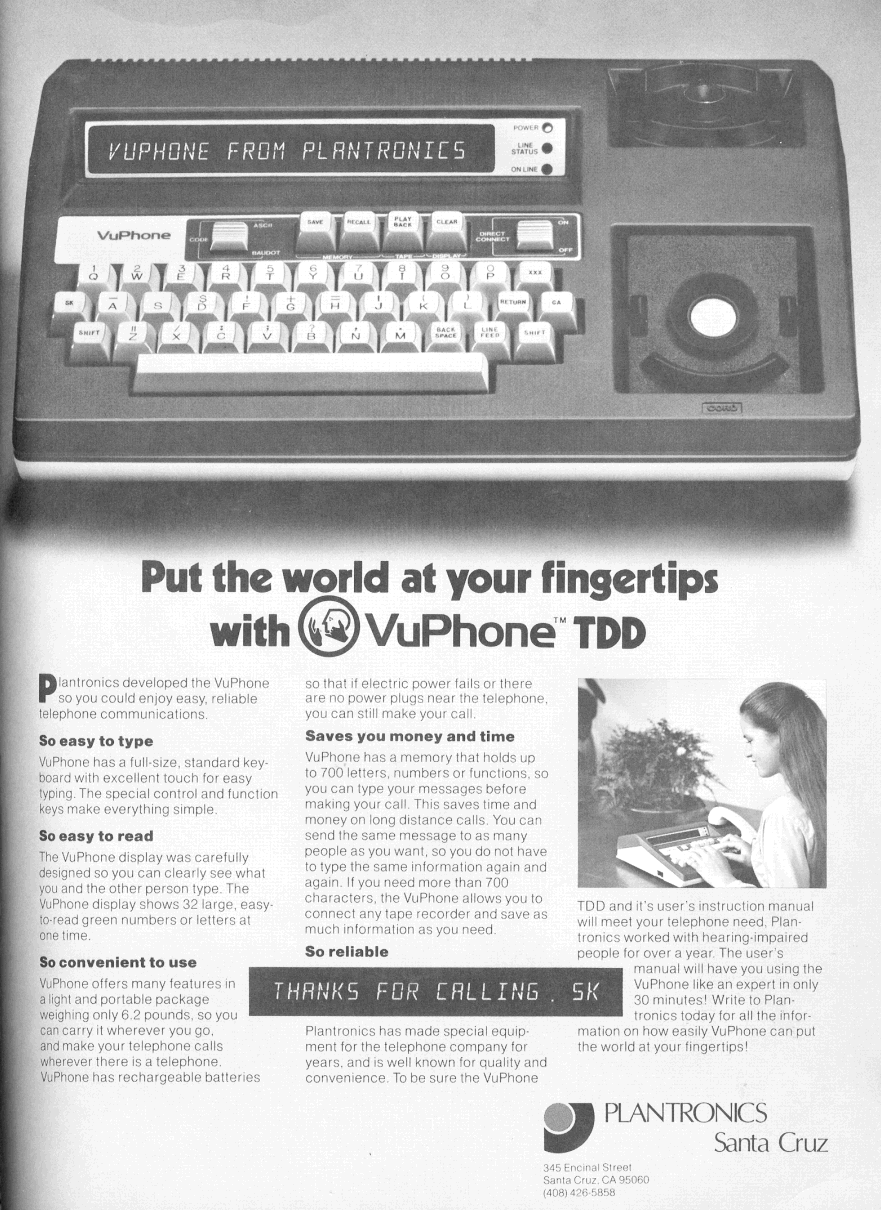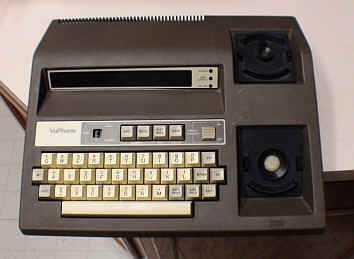Specifications For TDD Data Transmit/Receive
All TDD manufacturers follow these specs but no tolerance level is given:
1. Acoustic coupling (standard G- and K- type handset)
Input level: 65 dB SPL minimum / 110 db SPL maximum
-4 2
(0 dB SPL = 2 x 10 dyne/cm )
Output level: 95 dB SPL minimum / 100 dB SPL maximum
(acoustic pressure to produce a -9 dBm
signal at the telephone set line terminals
on an average loop)
2. Direct modular connection
Connector: standard 6-position modular jack
USOC No.: RJ11C
Input level: -50 dBm minimum / 0 dBm maximum
Output level: -13 dBm minimum / -9 dBm maximum
3. Modem
Modulation method: Frequency Shift Keying
Mark frequency: 1400 Hz +-5 Hz
Space frequency: 1800 Hz +-5 Hz
Signal to noise ratio: 13 dB
Carrier to data delay: 180 ms
Carrier to hold time: 156 ms
4. Protocol
Code: Baudot
Mode: Half duplex
Transmissions: Asynchronous
Start bit: 1
Stop bit: 1
Data bits: 5
Parity: None
Data rate: 45.5 baud (buffered)
Note: The above information is from Plantronics, Inc. (manufacturer of
the Vu-Phone) and is assumed to be consistent with other brands as the
Vu-Phone is compatible with all other TDD's.
(1985)
--------------
Curtis E. Reid
Rochester Institute of Technology
Put the world at your finger tips with VuPhone TDD
Plantronics developed the VuPhone so you could enjoy easy, reliable
telephone communications
So easy to type
VuPhone has a full-size, standard keyboard with excellent touch for
easy typing. The special control and function keys make everything simple.
So easy to read
The VuPhone display was carefully designed so you can clearly see what
you and the other person type. The VuPhone display shows 32 large,
easy-to-read green numbers or letters at one time.
So convenient to use
VuPhone offers many features in a light and
portable package weighing only 6.2 pounds, so you can carry it wherever
you go, and make your telephone calls wherever there
is a telephone. VuPhone has rechargeable batteries so
that if electric power fails or there are no power plugs near the
telephone, you can still make your call.
Saves you money and time
VuPhone has a memory that holds up to 700 letters, numbers or
functions, so you can type your messages before making your call. This
saves time and money on long distance calls. You can send the same message
to as many people as you want, so you do not have to type the same
information again and If you need more than 700 characters. the VuPhone
allows you to connect any tape recorder and save as much information as
you need.
So reliable

From the TDI International Telephone Directory of
the Deaf from the Paul and Sally Taylor Collection at
SMECC.
-- Telephone device for the hearing or speech impaired, TDD or TTY,
connects to any telephone with built in modem, some models have direct
hookup. Standard keyboard. 32 character green LED visual display. 700
character memory can store incoming message. A message can also be typed
before making call and sent all at once to save phone costs. With the
memory the same message can be sent to several people. Display will turn
off after 2 minutes of nonuse. Cassette recorder can be connected.
Portable, optional carrying case. Rechargeable backup battery for one hour
of use in power failures. No paper copy. (From
ABLE DATA )
Price: 750.00 to 650.00.
Manufacturer:
Plantronics, Inc.
345 Encinal Street
Santa Cruz, California 95060
United States
Telephone: 800-544-4660 or 831-426-5858.
Fax: 831-426-6098.
|
|
EXCERPT FROM
-
TECHNOLOGY
AND
HANDICAPPED PEOPLE
DECEMBER 1982
BACKGROUND
PAPER #2: SELECTED
TELECOMMUNICATIONS
DEVICES FOR
HEARING-IMPAIRED
PERSONS
Virginia W. Stern,
M.A.
Martha Ross
Redden, M. S., Ed.D.
Project on the
Handicapped in Science, Office of Opportunities
American
Association for the Advancement of Science, Washington, D.C.
COST OF TDDS
TDDs are still very expensive. The reconditioned
TTYs cost about $300 installed, with additional
fees for paper supplies and servicing, plus
the cost of the coupler ($250). For the past several
years, reconditioned TTYs have been almost impossible
to obtain and can usually be purchased
only from someone who is acquiring more modern
equipment.
A 1981 catalog of rehabilitative devices describes
10 portable TDDs made by different companies,
with prices ranging from $300 to $700, accessories
not included. One ultraportable model,
with somewhat limited use, sells for $200 (43). A
new Baudot model, the Minicom”, introduced by
Ultratec in 1982, is lightweight and sells for $259.
All these devices are beyond the budget of many
deaf families.
Recognizing that deaf TDD users would have
to purchase an expensive device before they had
access to the telephone lines, some States
(Michigan, Illinois, Florida, Georgia, and a few
others) lease TDDs for a monthly fee ($15 to $36
per month). Some States rent with an option to
buy. Hearing-impaired persons who use an amplifying
handset on their telephone pay $0.75 per
month for this service in some communities, and
$1.50 per month in others; there seems to be no
standard charge. Some telephone companies will
sell the amplifier to the customer for a $40 charge,
but it is difficult for the customers to find out
about this. As other adaptive devices, it is not
always easy for TDD users to know what is available
and what is the most economical way to obtain
it.
DISTRIBUTION OF FREE TDDS IN CALIFORNIA
An important step in distributing TDD units
for access to the telephone system was taken in
California in the fall of 1981. In 1979, owing to
the work of deaf consumer groups (particularly
GLAD, the Greater Los Angeles Council on Deafness),
the California legislature passed a bill requiring
the telephone companies to distribute free
TDD equipment to certified hearing-impaired customers
who could not use a standard telephone
(California SB 597). Governor Jerry Brown signed
the bill into law, and the California Public Utilities
Commission was charged with implementing it.
In September 1980, the Public Utilities Commission
began hearings to work out the practical
aspects of implementing this law that applies to
California’s 40,000 deaf residents. Almost all
TDDs owned by deaf Californians employed the
5-level Baudot code. TDDs were manufactured
by a number of small companies, many of which
were located in California and therefore had a
financial interest in specifications for the devices.
The issue of the modem code for TDDs was as
significant in the hearings as was that of the
system by which TDDs would be distributed.
Groups participating in the California hearings
had different goals. The conflict was an example
of the recurrent conflict between those with investments
in “old” technology and advocates of
“new” technology whose stand would inadvertently
make existing technology obsolescent
and necessitate the retraining of users. The
telephone companies wanted to implement the law
in the most economical and expeditious fashion.
The manufacturers of TDDs were competing for
the potentially lucrative equipment contracts from
the telephone companies. In general, the manufacturers
wanted to stick with the 5-level Baudot
code, because changing over to the 8-level
American Standard Code for Information Interchange
(ASCII) would be expensive. They also
feared competition from larger manufacturers
who had not served the deaf market before. The
deaf consumer groups were concerned about small
matters: hard or soft copy, red or green letters
in the light-emitting-diode readouts.
Other interested groups were also represented,
SRI International, a California-based consulting
firm, had just completed a 3-year grant project
totaling $375,000, that the National Institute of
Handicapped Research, Office of Special Education
and Rehabilitative Services, funded to develop
an ultraportable hand-held TDD terminal. (A
prototype was made and tested with representatives
of the deaf community; although the prototype
was smaller than any other standard
typewriter-keyboard TDD, it was expensive and
never came to production. ) The SRI team, which
included technology-minded deaf members, was
very concerned that deaf people, by using the
Baudot code, would become isolated from the
rapidly expanding world of computer communications.
One objective of the SRI project was to
develop a device that could be used with both
Baudot and ASCII systems and thus bridge the
gap between the two. SRI believed firmly that the
Baudot system was obsolete and that communication
systems for deaf people should be planned
with the future in mind.
After hearing all points of view, the California
Public Utilities Commission staff recommended
retaining the Baudot system, and the administrative
law judge followed their recommendation
in setting the standard. In an unusual turn
of events, however, the commissioners reversed
this decision and recommended that all free TDDs
had to have dual capacity, that is, to be compatible
with both Baudot and ASCII systems. Two
California manufacturers, Krown Research,
which makes the Portaprinter”, and Plantronics,
which makes the VU-Phone@, received the first
contract to produce the devices. * They agreed on
standardized modems to comply with the ruling
of the California Public Utilities Commission. A
trust fund was established to pay for the distribution
of TDDs. In October 1980, telephone customers
in California began to pay a 15¢ surcharge
on their monthly telephone bills. That surcharge
goes to the trust fund for TDDs.
Distribution of free TDDs by the telephone
company also began in October 1980, in Fremont,
Calif., where there is a substantial deaf community.
The distribution of free TDDs will continue
in other areas of the State and should be completed
by 1984. Customers will receive a free TDD
regardless of whether they already own one. Consumer
organizations in different California communities
are working with the telephone companies
to arrange to identify eligible consumers.
There is also the question of possible loss or disappearance
of equipment to consider. For example,
when a deaf person moves, does the person take
the free TDD along?
Although the California decision may seem like
the pot of gold at the end of the rainbow, there
are some members of the deaf community who
do not support the free distribution of equipment.
They are willing to make the purchase of a TDD
a medical deduction on their income tax.** They
agree that low-income deaf people should be provided
with TDDs at reduced cost, but they don’t
want gifts. They worry about other consumers’
reaction to having to pay for the devices with a
surcharge on every month’s phone bill, or about
the stereotyping of all hearing-impaired people as
“poor.” (The charge on the telephone bills now
reads “SB 597-TDD, ” which puts the responsibility
on the State legislature, At one point it was
suggested that the charge be titled “DEAF,” an
acronym for Deaf Equipment Acquisition Fund,
but that idea was rejected. )
As of July 1982, 4,000 units had been placed
in California —fewer than expected. Many deaf
people have no telephone or perhaps do not wish
to reveal their poor language or typing skills. The
trust fund has accumulated enough money that
the surcharge may be reduced.
*VU-Phone is not currently being manufactured.
**The Internal Revenue Service began allowing a medical
deduction for TDDs in 1971.
|



